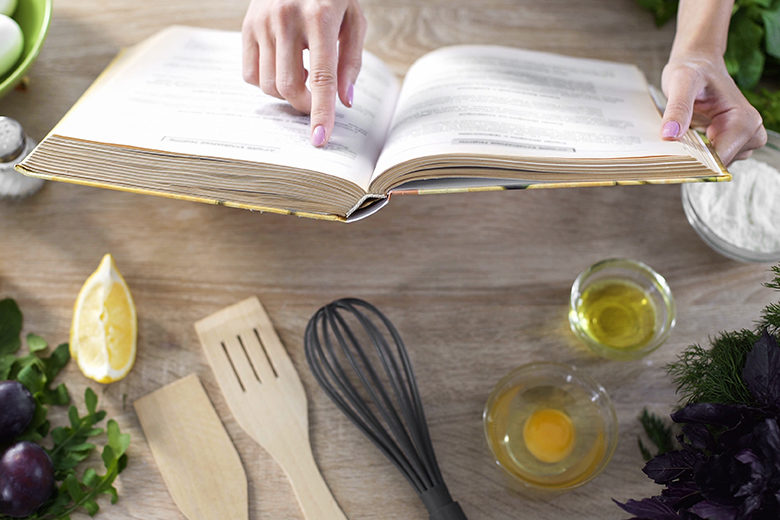
I don’t really have a hard time writing down recipes as I’m cooking. Because I’ve been reading cookbooks like novels for a long time, recipe writing comes naturally to me. I get an idea, write down my ingredients and their amounts on a notepad (or my phone), and immediately get on the computer after the dish is done to write down the preparation steps (because my notes are super messy).
For some, it might be a bane and totally time-consuming. For me, it’s kind of fun! For those of you who have trouble communicating how your dish gets so spectacular, here are a few guidelines on how to write a recipe. I’ll use an older recipe as an example — it’s not a “perfect” recipe, but can be a template for how you would like to word things.
Stir-fried Egg Noodles with Kale, Red Bell Pepper & Baked Tofu
Recipe by Tram Le, MS, RD
Serves 4-6
Ingredients
2 Tbsp extra-virgin olive oil
4 garlic cloves, minced
6 cups (3 1/4 oz) chopped kale leaves
1 cup red bell pepper, chopped
Pinch of kosher salt
15 oz cooked egg noodles
2 Tbsp oyster sauce (or vegetarian oyster sauce)
7 oz teriyaki-flavored, baked & marinated tofu
Black pepper, to taste
Instructions
- In a large skillet over medium heat, heat the 2 Tbsp extra-virgin olive oil until hot.
- Add the garlic and saute for 2 minutes.
- Add the kale, red bell pepper and pinch of salt. Sauté for about 6 minutes, until kale is wilted.
- Add the egg noodles and oyster sauce and stir-fry until all is incorporated.
- Add the baked tofu and continue to sauté until hot, about 3-4 minutes.
- Add the black pepper to taste, and serve!
At the top, you have the recipe’s name and the amount of servings yielded from that one recipe. You can also write the serving size here, or include it at the end of the preparations section, which I sometimes do (when I do write the nutrition facts per serving, I enter it at the bottom of the recipe).
Then list the ingredients. If I was more formal, I would spell out tablespoons, ounces, etc (I did that when I co-authored the book, Inspired Celebrations, with Ngoc Nguyen-Lay and Caroline Tran, but I generally don’t do that on my blog, possibly because of laziness).
A few things to note here:
- List the ingredients in the order that you use them in the methods section. It reads easier and allows the recipe-follower to get organized and not scramble for ingredients.
- Write appropriate measurements. For example, use a liquid measuring cup for liquids and oils, and a dry measuring cup for flours, sugars, spices or cocoa. Also, meats are measured in ounces and pounds, NOT CUPS! I just had to mention that since I saw another blogger do that once. Never have I seen “5 cups of chicken drumstick” in a cookbook. That’s just silly. If you don’t know how many ounces or pounds you used, get a food scale. It’ll make your life (and those following your recipe) MUCH easier.
- It’s important to write descriptives, like “butter, softened,” or “eggs, whisked,” or “red bell pepper, chopped” if it matters in your recipe.
- If you have multiple components that make up your dish, like pie crust and filling, divide up the ingredients with subheadings, so the reader knows that he or she is making separate things that will be combined later.
After you have the ingredients, write the preparation section. Be sure to keep in mind the following:
- Write down EVERY STEP you take in the kitchen. If you preheat the oven first, write it down. No one likes to wait an extra 15 minutes after they’ve prepared something to find out that the oven is not turned on!
- Write down the tools you use in this section. Small mixing bowls, whisk, spatula, 10-inch skillet, 7-quart Dutch oven, etc. All important to know.
- Be specific. If you turn the heat on the stove to medium-high, write it down. If you sauté something until it’s lightly browned, or wait until the onions caramelize, write that down, too.
- If you have different components of preparation, separate them out with subheadings. For example, “cupcake” and “frosting.”
So, these are some guidelines on how to write a recipe. Keep your explanations and sentences short and simple. People are supposed to read an entire recipe through before they start cooking or baking, but it is your job to act like they haven’t, and break it down step-by-step for readers so they are well-prepared when they make your dish and things go smoothly.




